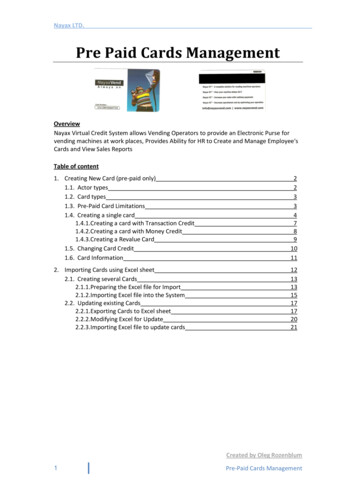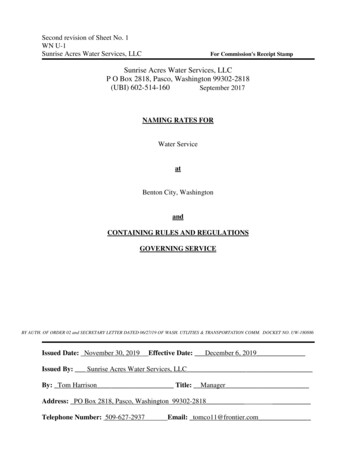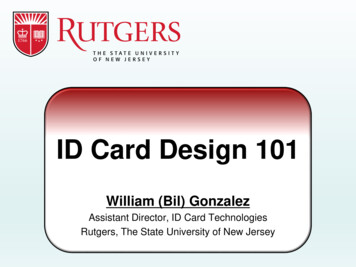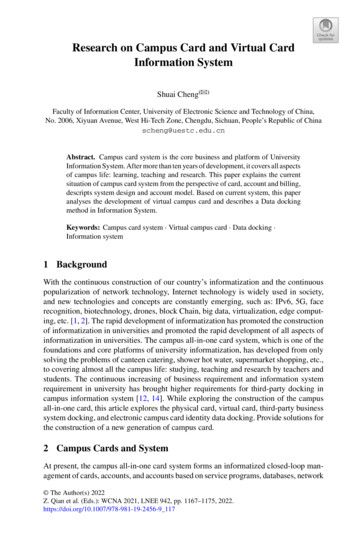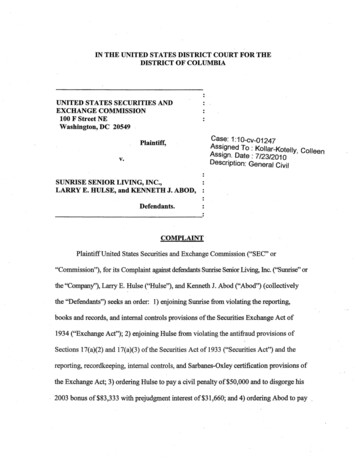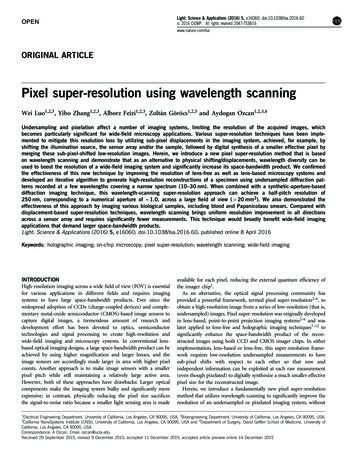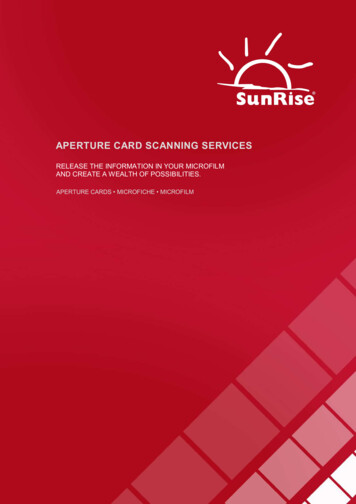
Transcription
APERTURE CARD SCANNING SERVICESRELEASE THE INFORMATION IN YOUR MICROFILMAND CREATE A WEALTH OF POSSIBILITIES.APERTURE CARDS MICROFICHE MICROFILM
DIGITISING APERTURE CARDSPunch cards in their roughest form were invented in the early1800’s as a system to control loom weaving patterns. Thetechnology advanced over the years. Around 1890 HermanHollerith created the electromechanical punch code. Hollerith’scode became the standard language used on punch cards as weknow them today.Manufacturers had a need for an easy, condensed andinexpensive way to transport and archive their images as well asinformation so punch cards were further adapted to include anaperture hole on the right side of the card where a microfilmedimage could be placed.For decades, aperture cards were the preferred method of datastorage for many industries due to their ability to be easily read,indexed, stored and quickly retrieved by computer. With thearrival of digital technologies and the internet it was possibleto immediately transfer information across the globe - the need tosend physical copies of the cards was becoming redundant.With all the advantages digital media has over microfilmorganisations are now converting their aperture cards in toelectronic versions. This process, if completed correctly, offersunlimited sharing, access and back-up possibilities - it willtransform your aperture card library and how you manage theinformation.FINDING THE RIGHT PROVIDERSunRise have over 2 decades of experience working withaperture cards. We not only scan all forms of microfilm we alsomanufacture market leading scanners that are used by moreorganisations and scanning bureaus than any other scanner inthe world. Couple this with our professional, friendly approachand we guarantee we can provide you with the right solution thatworks with your budget, timescales and operational needs.SunRise Imaging 020 8255 2011 info@sunriseimaging.co.uk
APERTURE CARDS - THE IMPORTANCE OF IMAGE QUALITYPredominantly the information stored on an aperture card is usually of sometype of reference document, such as an engineering drawing or plan. Due tothe amount of detail these images hold it is essential to scan at an optimalimage quality to ensure an accurate digital copy. It’s all about resolution!IMAGE RESOLUTIONResolution is a measurement of how many pixels a scanner can sample in agiven image and is measured in a grid. For example, a chessboard witheight squares along each side has a resolution of 8 x 8. If the chessboardhad 300 squares along each side, its resolution would be 300 x 300. Ifscanning an image at a resolution of 300 - that scanner samples a grid of300 x 300 for every square inch of the image, a single square on the grid isknown as a pixel. A one inch grid with 300 x 300 resolution contains 90,000individual pixels. With a higher resolution scan you get more pixels, with alower resolution scan you get less.TRUE OPTICAL RESOLUTION SCANNINGA scanner's optical resolution is determined by how many pixels it canactually see. For example, a scanner using a scanning head with 300sensors per inch, will sample 300 dots per inch (dpi) along the width of theimage. To scan along the length, it will move the scanning head down theimage, pausing 300 times per inch, to scan 300 dpi along the length. Eachpixel captured is a true digital copy of what the scanner head saw on theoriginal aperture card image.INTERPOLATED RESOLUTIONUnlike Optical Resolution scanning an interpolated resolution measures howmany pixels the scanner can guess at. Through a process calledinterpolation, the scanner turns a 300 x 300 dpi scan into a 600 x 600 dpiscan by inserting new pixels in between the old ones, and guessing at whatlight reading it would have sampled in that spot had it been there. TheInterpolation scanning process almost always diminishes the quality of thescan, and should therefore be avoided.Image quality is just one technical aspect in the process of converting aperturecards to a digital format. There are a number of technically based decisions thatneed to be made - decisions that will ultimately impact the success of the project.SunRise will guide you through every step and explain the various options allowingyou to make informed decisions.SunRise Imaging 020 8255 2011 info@sunriseimaging.co.uk
A QUALITY SOLUTIONSunRise are ISO 9001:2008 accredited and we follow strict procedures whenhandling your aperture cards and are committed to the continual improvement of ourservices. We perform checks during the scanning process to ensure we meet thehighest levels of accuracy and quality.The security and confidentiality of our clients’information is at the heart of everything we do.A BESPOKE SOLUTIONEvery microfilm conversion project has unique elements and varying requirementsmeaning the solution is always bespoke. Whatever your film format, we can help: 16mm (simplex or duplex); 35mm roll filmJacket fiche (standard 16m, 35mm or combination fiche)Diazo ficheCOM (Computer Output to Microfilm) ficheAperture cardsWe can digitise your microfilm in to various formats: JPEG PDF Multi page TIFF Searchable PDF TextSunrise can deliver images in the following methods: CD or DVD USB Flash Drive Email Secure FTP Via an ECM systemA SOLUTION YOU CAN TRUSTAt SunRise we take security seriously we take every precaution to ensure we protectyour information in both physical and digital form. We constantly review ourprocesses and security measures to guarantee customer peace of mind.SunRise are committed to offering a fully confidential service. The security andconfidentiality of our clients’ information is at the heart of everything we do. Whetherit is intellectual property or sensitive client information protection of that informationis paramount.All scanning work is completed at our Wallington sitewhich affords the following security features: 24/7 on-site manned security 24 hour CCTV surveillance Our scanning bureau is located within aninternal secure facility, which provides a secondlayer of security Our storage servers have no connection to theinternet or external networks, ensuring ALLstored data is totally secure All data is returned to you by hand on passwordencrypted DVD, external USB HDU, USB sticks,via secure FTP or directly in to your ECM ordocument management systemSunRise Imaging 020 8255 2011 info@sunriseimaging.co.uk
THE SUNRISE APERTURE CARD SCANNERSCANNING THE WORLDS MICROFILMSunRise Imaging is the international market leader for highperformance microfilm digitising systems. SunRise scannersare used in more libraries, government agencies, statearchives, service bureaus and corporations than any otherscanner in the world.-SCAN FEATURESWide range of film Reduction Ratios.Low reduction (7x) micro film images are large, are scanned athigh speed. High reduction (70x) micro films are very small,are scanned at low speed.STANDARD MICROFILM SIZESStandard 80 column Aperture Cards are supported. Scan largeimages (Engineering Drawings), or several images on a grid.STANDARD HOLLERITH TYPES57 columns to left, 8 columns to right of image.Use Hollerith fields in naming files.FILM TYPES80 column Hollerith cardSingle image pocketMultiple T -card pocketAUTO FEEDLoad hundreds of cards into the feeder, and the scanner runsunattended. Scan rate of 10 cards per minute.OPTICSHigh Quality Nikon 60mm Macro lensExtremely sharp focusF2.8 to F32 Depth of field controlFilm Shutter insures film is flatAccepts Extension Tubes to lower Reduction RatioSunRise Imaging020 8255 2011info@sunriseimaging.co.uk
RELEASE YOUR INFORMATIONSet up in 2004, SunRise EMEA has grown and developed into a keypartner for businesses looking to scan just about any type ofdocument, books, maps, plans, film media, from 16mm & 35mm rollfilm, fiche, both COM, Jacket and Diazo and of course Aperturecards. With years of expertise, knowledge and know-how SunRisecan provide scanning services for any size of scanning project,whether it be a single box of documents, to a full conversion of yourorganisations paper or film libraries.For more information on our services and how SunRise Imaging caneffectively manage the conversion of your information into digitalassets, contact us by visiting: www.sunriseimaging.co.uk, call us on 44 (0) 20 8255 2011 or via email: info@sunriseimaging.co.uk
For example, a scanner using a scanning head with 300 sensors per inch, will sample 300 dots per inch (dpi) along the width of the image. To scan along the length, it will move the scanning head down the image, pausing 300 times per inch, to scan 300 dpi along the length.


